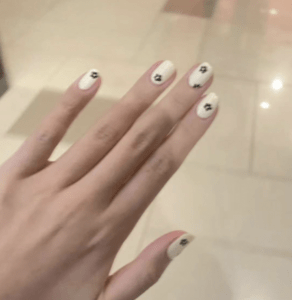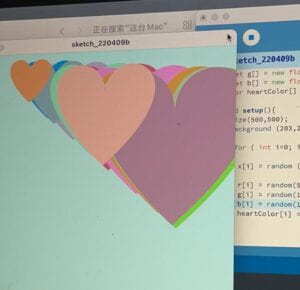For this recitation, we use sound to do a lot of exercises.
In the first exercise, we use keys to control the start of two sounds.
The code is below:
import processing.sound.*; // declare three SoundFile objects SoundFile kick; SoundFile snare; void setup() { size(640, 480); // create the objects and load sounds into them kick = new SoundFile(this, "kick.wav"); snare = new SoundFile(this, "snare.wav"); } void draw() { background(0); } void keyPressed() { // when a key is pressed, use a switch statement // to determine which key was pressed // and play the appropriate sound file and set a background color switch(key) { case 'k': kick.play(); background(255, 0, 0); break; case 's': snare.play(); background(0, 255, 0); break; } }
The video:
In the second exercise, we use the vibration motor to detect and show the beats of the song “Lost On The Free Way”.
The code is below:
For processing:
import processing.serial.*; int NUM_OF_VALUES_FROM_ARDUINO = 1; /** YOU MUST CHANGE THIS ACCORDING TO YOUR PROJECT **/ int sensorValues[]; /** this array stores values from Arduino **/ String myString = null; Serial myPort; import processing.sound.*; // declare an AudioIn object SoundFile sound; // declare an Amplitude analysis object to detect the volume of sounds Amplitude analysis; void setup() { size(500, 500); sound= new SoundFile(this, "Lost On The Freeway.mp3"); sound.play(); // create the Amplitude analysis object // use the microphone as the input for the analysis analysis = new Amplitude(this); analysis.input(sound); setupSerial(); } void draw() { background(0); println(analysis.analyze()); background(0); float volume = analysis.analyze(); // map the volume value to a useful scale float diameter = map(volume, 0, 1, 0, width); // draw a circle based on the microphone amplitude (volume) circle(width/2, height/2, diameter); getSerialData(); sensorValues[0]=int(map(analysis.analyze(),0,1,0,200)); } void setupSerial() { printArray(Serial.list()); myPort = new Serial(this, Serial.list( )[6], 9600); myPort.clear(); myString = myPort.readStringUntil( 10 ); // 10 = '\n' Linefeed in ASCII myString = null; sensorValues = new int[NUM_OF_VALUES_FROM_ARDUINO]; } void getSerialData() { while (myPort.available() > 0) { myString = myPort.readStringUntil( 10 ); // 10 = '\n' Linefeed in ASCII if (myString != null) { String[] serialInArray = split(trim(myString), ","); if (serialInArray.length == NUM_OF_VALUES_FROM_ARDUINO) { for (int i=0; i<serialInArray.length; i++) { sensorValues[i] = int(serialInArray[i]); } } } } }
Arduino code:
// IMA NYU Shanghai // Interaction Lab /** This example is to send multiple values from Processing to Arduino. You can find the Processing example file in the same folder which works with this Arduino file. **/ #define ZD 3 #define NUM_OF_VALUES_FROM_PROCESSING 1 /** YOU MUST CHANGE THIS ACCORDING TO YOUR PROJECT **/ /** DO NOT REMOVE THESE **/ int tempValue = 0; int valueIndex = 0; /* This is the array of values storing the data from Processing. */ int processing_values[NUM_OF_VALUES_FROM_PROCESSING]; #include <Servo.h> Servo myservo; // create servo object to control a servo int potpin = A0; // analog pin used to connect the potentiometer int val; void setup() { Serial.begin(9600); pinMode(ZD,OUTPUT); } void loop() { getSerialData(); analogWrite(ZD,200); delay(5000); analogWrite(ZD,0); delay(1000); analogWrite(ZD,100); delay(5000); analogWrite(ZD,0); delay(1000); // add your code here using elements in the values array //this is an example connecting a buzzer to pin 8 /* if (processing_values[0] == 1) { //turn on an LED when the mouse is pressed digitalWrite(13, HIGH); // map values from mouseX to frequency from (0 - 500 pixels) //to the output pitch range (120 - 1500Hz) int f = map(processing_values[1], 0, 500, 120, 1500); // map values from mouseY to frequency from (0 - 500 pixels) //to the output duration range (10 - 2000 milliseconds) int d = map(processing_values[2], 0, 500, 10, 2000); // play the pitch: tone(8, processing_values[1], processing_values[2]); delay(1); // delay in between reads for stability } else { digitalWrite(13, LOW); } */ //end of example } //receive serial data from Processing void getSerialData() { while (Serial.available()) { char c = Serial.read(); //switch - case checks the value of the variable in the switch function //in this case, the char c, then runs one of the cases that fit the value of the variable //for more information, visit the reference page: https://www.arduino.cc/en/Reference/SwitchCase switch (c) { //if the char c from Processing is a number between 0 and 9 case '0'...'9': //save the value of char c to tempValue //but simultaneously rearrange the existing values saved in tempValue //for the digits received through char c to remain coherent //if this does not make sense and would like to know more, send an email to me! tempValue = tempValue * 10 + c - '0'; break; //if the char c from Processing is a comma //indicating that the following values of char c is for the next element in the values array case ',': // processing_values[valueIndex] = tempValue; //reset tempValue value tempValue = 0; //increment valuesIndex by 1 valueIndex++; break; //if the char c from Processing is character 'n' //which signals that it is the end of data case '\n': //save the tempValue //this will b the last element in the values array // processing_values[valueIndex] = tempValue; //reset tempValue and valueIndex values //to clear out the values array for the next round of readings from Processing tempValue = 0; valueIndex = 0; break; } } }
Video:
The vibration motor is kind of scary hahaha, but the moving circle is very cool that gives a feel to the atmosphere and make the music even more popping and even interactive for it engages sights in the processes of enjoying music. It was a bit hard to use the map function for a proper extent, and it was also quite tricky when making the portfolio, for the music must be included in a portfolio called data with the processing sketch in the same portfolio.
In the homework part, we tried to use amplitude to draw something on Processing, I chose to draw a line that goes up and down accordingly.
The code:
import processing.sound.*; // declare an AudioIn object AudioIn microphone; // declare an Amplitude analysis object to detect the volume of sounds Amplitude analysis; int x=0; float prediameter; void setup() { background(198,236,255); size(640, 480); // create the AudioIn object and select the mic as the input stream microphone = new AudioIn(this, 0); // start the mic input without routing it to the speakers microphone.start(); // create the Amplitude analysis object analysis = new Amplitude(this); // use the microphone as the input for the analysis analysis.input(microphone); } void draw() { println(analysis.analyze()); // analyze the audio for its volume level float volume = analysis.analyze(); // map the volume value to a useful scale float diameter = map(volume, 0,1, 200, 0); // draw a circle based on the microphone amplitude (volume) x=x+1; strokeWeight(5); stroke(252,199,199); line(x, prediameter,x+1,diameter); prediameter=diameter; }
Video:
It’s really fun to “see” your voice and to make different waves with it. However, it’s not so sensitive, I need to be very loud or very sharp can I make the line wave dramatically.






